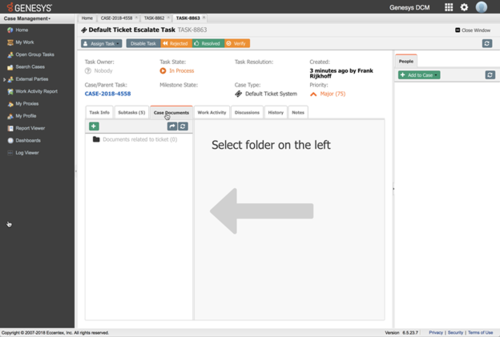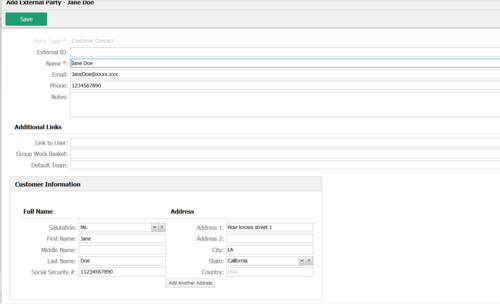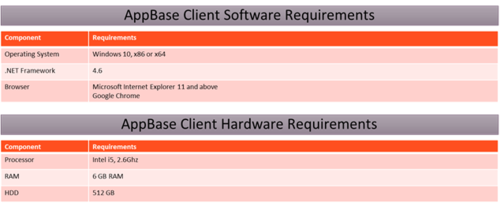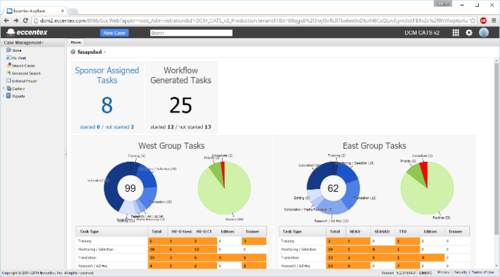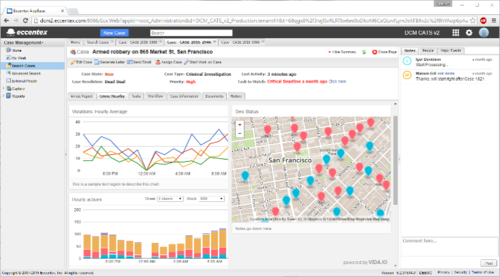Genesys Dynamic Case Management (BO11) for PureConnect
What's the challenge?
Contact center, back office and enterprise employees struggle to handle non-linear and human centric processes efficiently.Customer promises are broken as work falls through the cracks. Employee morale suffers with unfair workloads. Customer experience is suffering because back-office and front-office operations are not well integrated.
What's the solution?
Genesys Dynamic Case Management (DCM) provides a no-code/low-code integration with DCM solutions to automate the distribution of structured and dynamic work. Drive process improvement, improved visibility, and faster case resolution with back-office automation and a single user interface for case management.
Contents
Use Case Overview
Story and Business Context
Dynamic Case Management (DCM) enables Genesys customers to leverage the back-office automation capabilities to help employees and supervisors better manage cases. Companies can improve processes for the resolution of cases by:
- Providing a single interface for case resolution
- Breaking the inflexibility of current processes
- Getting a 360◦ view on the process handling and associated SLAs
- Increasing advisors' satisfaction and autonomy
- Increasing supervisor visibility and control
- Giving agents visibility into other tasks or people associated with their immediate work
In addition to this, the benefits can be combined with the Workload Management use cases. For more information, see Genesys Work and Lead Distribution (BO02) for PureConnect. Various Genesys partners can deliver the DCM component of this use case. While Genesys can integrate with many DCM partners, this use case focuses on Eccentex Appbase DCM offerings. To illustrate this use case and make it more tangible, we have provided technical information from the Eccentex platform. In a future release, we will introduce technical details from other vendors. If you are interested in another case management solution provider, the Genesys account team can help you contact our Genesys solution leads. The Genesys DCM solution can be deployed on cloud, on-premises, or in a hybrid model. Genesys DCM brings the omni-process concept, allowing integration of data and tools into a single user interface. This enables agents and advisors to work on a single application instead of having to switch between applications to resolve cases. In the background, the solution orchestrates the flow of information, ensuring that the required information is provided to the agents and advisors at the right time. The solution replicates new input in the relevant back-end systems.
Use Case Benefits*
The following benefits are based on benchmark information captured from Genesys customers and may vary based on industry, lines of business or Genesys product line:
| Use Case Benefits | Explanation |
|---|---|
| Improved Customer Experience | Consistent customer experience for non linear case management scenarios and channel agnostic. |
| Improved Employee Utilization | Unified desktop and user experience optimized for dynamic case resolution. |
| Improved Insights and Visibility | Improved customer visibility of the case and improved employee insights in case handling and management. |
| Increased Response Rates | Enforced service level management based on contextual information and business rules to drive response rates. |
| Reduced Penalties and Fines | Drive work to be resolved prior to breaching the service level, legal, operational or contractural obligations and optimize the use of your resources. |
Summary
Genesys sees the digital journey of the customer as something more than a technological process to be managed by a customer relationship management (CRM) or business process management (BPM) tool; rather, it is a whole-person digital journey that serves the customers on their terms in ways most effective for their needs at any one time or at any one place.
Genesys DCM provides customers with building blocks for the future to deliver automation, efficiency, sales, marketing, enhanced customer service, and a better experience for customers, employees, and external partners. Although Genesys is an open platform that supports integration with hundreds of other products and solutions in the market, the proposed approach is the recommended solution to provide a human-centric DCM omnichannel experience.
Use Case Definition
Business Flow
Case Capture
This use case supports two types of case capture.
- Web form capture: Use of a web form that could be integrated into your web site, portal and or intranet environment. Genesys provides a web form, that allows customers and internal employees to create new cases and provide the required information for case creation as part of the scope.
Note: The integration in the selected web site, portal and or intranet portal and the adaptation to the company layout and security requirements of this web page are both out of the scope for this use case.
- Employee capture:The customer will get in touch with contacts the front-line employee through a communication channel (for example: voice, email, chat, social, SMS, Apple Business Chat, etc.) Note that the provisioning of the communication channel(s) is out of scope and could be delivered by Genesys through several other use cases.
Business Flow Description
- A customer/employee is browsing the company website portal or intranet
- On the site, a form is presented. Upon completion, a new instance of that specific case type is started
- An automated email is sent to the customer, based on the provided email address in the form, to confirm that the case is now created
- After the case starts, a new task is created and sent to a workgroup or Advisor, based on ACD properties such as Skill, Priority, etc.
- Advisor picks up the work in the client application task form, for the Advisor to provide all information needed to complete that task
- If Advisor cannot resolve the task, it can be escalated, meaning send the task/case to another (2nd Level / Expert) group to work on
- If Advisor can complete the task, the case will be closed and an automated email with results sent to the customer
- If Expert can complete the task, the case will be closed and an automated email with results sent to the customer, or the Expert can choose the option to send it back to the original Advisor for closure (verification)
Business Flow
In Eccentex DCM, the case workflow (procedure) looks like:
On each task (dark blue) an SLA can be set to meet your business’ SLA’s (depicted by the green clock icons). Based on the Employees wrap-up (completion) code on the first task (resolved, rejected to escalate) the next step is taken. This could be automated closure with sending the customer a confirmation email/SMS/Notification with the outcome, or a new task sent to an escalation group. The initial task looks like:
The “Escalation” tasks looks like:
These tasks can be embedded in the Advisor or Expert contact center application (such as Interaction Connect).
Business Flow Description
Business Flow
Business Flow Description
Business and Distribution Logic
Business Logic
Case creation
For this use case, we have foreseen three ways of initiating a new case. A new case can be created: 1. Via a web form on a public or internal website. Completion of this form triggers a web service call, which creates a new case in DCM via its open API. 2. Via DCM user interface. An advisor or expert can create a new case manually. This method can be used if email or voice channels are used. The advisor (agent) who handles the call or email manually creates a new case. see:
3. Via the Eccentex Smart API. This allows the creation of cases by other backend systems.
Distribution Logic
Simple DistributionThis use case includes simple distribution logic, where tasks are sent to workbins and it is up to the employees and experts to ensure they are processing the tasks according to the expectations of the company. Advisors need to pull tasks from their associated workbins.
The escalation monitoring part of the process ensures tasks are processed in due time, by sending at-risk tasks to experts.
This use case also enables supervisors to assign tasks from team workbins to one of their employee's workbins.
Advanced distribution
The advanced distribution can be implemented if one of the optional Workload Management distribution use cases has been selected and is deployed at the same time.
In this section, highlights some of the benefits of combining this use case with a workload distribution use case:
- No cherry picking
- Ensure employees and experts are working on the most important tasks for the company first
- Measure employees and experts handling time
- Enabling workforce management/optimization for employees and experts
- The push of tasks reduces allocation bias and idle time
- Employee performance visibility for the individual as well as for the supervisors
- Fair distribution of tasks
For more information on these high-level benefits, refer to the Workload Management distribution use cases (Genesys Work and Lead Distribution (BO02) for PureConnect
An additional benefit of combining use cases includes:
- Fewer groups need to be configured in DCMAs distribution because additional parameters (for example, Language and Case_Type), enable each group to support multiple possibilities.
For example: Enterprises no longer need to foresee different target groups for all the languages and/or segments you support for a specific case type. The routing engine takes into consideration the skills (languages, segments, etc.) and proficiency levels of the advisors in the task distribution.
Advisor Case handling
Simple Case Handling environment
The Eccentex platform comes with its own advisor environment, where employees can review and manage the tasks to which they are assigned. With access rules, it is possible to provide the right visibility and capabilities to each of the people involved in the handling of the case.
Advanced Case Handling environment
If a Workload Management use case will be deployed with this use case, beyond the additional routing and distribution capabilities, new capabilities will also be provided to the employees.
With the Workload Management use case, an Advisor (Agent) toolbar is provided. With the toolbar, employees can log in and put themselves in the desired mode (for example, selecting their login status and ready state, communicating with colleagues, etc.). They can also easily interact with customers if some communication channels are available. Once they receive new tasks, they can get preview information and contextual information to provide an enhanced customer experience.
Note that all standard case handling capabilities are unchanged as the Eccentex DCM interface appears in a frame of the Advisor/Agent toolbar as shown below.
Escalation Process
Escalation criteria
The following escalation criteria are foreseen in this use case:
- Operation level agreement (OLA) for the task.
- If a task is not performed in OLA time, the task is automatically escalated. OLA monitoring can escalate the task at any step of the normal handling flow. The only exception to this is if an advisor is currently effectively working on the task (task's screen open and active on the desktop). In this case, the task will be subject to escalation if the advisor does not finish the case before closing the task window. As there is only one escalation mechanism, escalated tasks cannot be further escalated. Note: Adding Genesys Work and Lead Distribution (BO02) for PureConnect to this use case provides significantly more escalation options.OLA should be smaller than Case SLA, to allow sufficient time for experts to resolve the case. SLA and OLA can be defined in Open Office time or Calendar time. (Allowed format: Days; hours; Minutes)
- Advisor manual escalation.
- An advisor handling a task can decide to escalate the task if they think this is appropriate to secure in time 'Case Resolution.'
Detail escalation process
Once a task has been escalated, it will always follow the same escalation path. The target escalation expert group can be determined based on the case type.
Note:Adding Genesys Work and Lead Distribution (BO02) for PureConnect to this use case allows for escalation based on any metadata or context around the case.
| Case_Type | SLA | SLA/OLA Type | Handling_Target | OLA | Escalation_Target |
| Technical | 16 hours | Open office time | Employees_group_A | 12 hours | Expert_group_X |
| Finance | 3 days | Open office time | Finances_group_B | 2 days | Team_Supervisor |
| Replacement | Calendar time |
Field_service_group_C |
8 days | Express_delivery_team |
Once one of the escalation criteria is met, the associated task is escalated and the task is sent to the escalation target. The experts associated with this target then receive the escalation in their inbox and are responsible for handling it as quickly as possible. Supervisors can monitor the tasks (normal and escalated) through the reporting interface. Based on the input, they can assign or remove additional employees or experts. They can also change the task's targets and OLA/SLA.
Live notifications
At several steps in the process, notifications can be activated. The activation of the different notifications can be done based on the case type. Administrators and/or supervisors can alter the content of the notification messages. Assuming several notification channels are available, the selection of the notification channel can be done based on case type (communication channels will not be delivered in the scope of this use case).
| Case_Type | Creation Notif | Create Notif Change | Assign Notif | Assign Not. Change | Other Notify |
| Technical | Yes | No | ... | ||
| Finance | Yes | SMS | Yes | .. | |
| Replacement | Yes | Yes | Mobile Notification | .. |
The content of the different live notification messages is configurable by the administrator and/or supervisors.The message is the same for all case types, but the message supports the following variable information:
- Case_Type (for example: Technical, Finance, Replacement)
- Case_Description (for example: technical issue)
- Case_Id (for example: 1234566 2346)
- Case_SLA (for example: 12)
- Case_SLA_format (for example: Days, Hours, Minutes)
- Case_SLA_Type (for example: Open office time/ calendar time)
- Case_Target (for example: Finances_group_B)
- Case_Creation_Date
- Case_Creation_Time
- Case_Status
Other variables coming from the case creation forms (Maximum of 20 fields. This is not a technical limitation, for more than 20 fields, additional PS effort is required.)
Examples of variables that can be captured in the creation form:
- Customer_Name
- Customer_ Firstname
- Customer_Id
- Customer_Email
- Customer_Segment
- Customer_request_description
- ....
Example of Message::
Dear ,
With this email, we want to confirm that an ACME ticket has been created for your request < Case_Creation_Date> at < Case_ Creation_Time>. The related identifier for your ticket is the following.
You will receive an answer from us in the time frame.
Best regards
The ACME Company
Portal Case status dashboard frame
This use case can also come with case status dashboard for the customer, this is only applicable if the customer has been identified during the case creation and if the company is providing personalized portal capabilities to their customers. In this case, the Dynamic Case Management platform can provide a web dashboard with all the cases associated to this customer, as well as the status of these cases.
Any combination of the Case _Variables and case creation variables can be presented in this dashboard.
Case_ID, Case_Status, Case_Type, Case_SLA....
Note that the integration of this case status dashboard in the existing company portal is not covered in the scope of this use case. This integration can be done or by customer resources or partner resources.
CRM-Light- customer profile storing
The Dynamic Case Management platform comes with an out of the box CRM Light capability. It stores customer profile data, which can be used in this case management process (such as customer search, case report based on the customer).
In the scope of this use case allows for the addition of up to five fields to the default customer profile data template. Additional fields can be added but are subject to a separated quote.
User Interface & Reporting
Agent UI
Reporting
Real-time Reporting
Real-time, interactive reporting in the browser is achieved with AppBase Dashboards.
Reporting capabilities rely on 3rd party tools to achieve Business Intelligence and Big Data Analytics. Specifically, DCM works primarily with JasperSoft.
Standard reporting provided:
- Number of cases open per Case
- Case status report Per Case Type
- Specific View on escalated Case
Historical Reporting
- Number of cases open, closed, escalated per Case type in a defined period
- Number of Cases closed per advisor in a defined period
- Number of cases manually escalated per case types and per Advisor in a defined period
- Report on closer times per case types in a defined period (+ average closer time per case types)
For more information, see About Interaction Reporter.
Tuned reports
The Platform allows also the possibility to create tuned reports for the specific needs. Tuned reports, can be requested and will be subject to an additional Professional services Quote (out of scope of the standard Use Case).Samples of tuned reports:
Customer-facing Considerations
Interdependencies
All required, alternate, and optional use cases are listed here, as well as any exceptions.
| All of the following required: | At least one of the following required: | Optional | Exceptions |
|---|---|---|---|
| None | None | Digital
Inbound Outbound Self-Service and Automation |
None |
General Assumptions
- Compatibility with DCM hardware and software requirements.
- Customer should allow access to the DCM Platform for their users, involved in the process.
This use case does not include any system integration. The case submission web form and web dashboard (provided in scope) will not be integrated into the existing web environment of the customer. On request of the customer, this integration could be done by Genesys resources, but this will be subject to a separate quote by Professional Services. Customer may also choose to implement this integration with its own or partner resources. The customer should provide the communication channel(s) for the customer notification (such as email, SMS and notification gateways). If the relevant notification channel(s) are available, the use case supports the following notification types:
- Email (requires customer email address)
- SMS (requires customer mobile number)
- Mobile notification (requires customer mobile number).
Note that Genesys can provide optional additional routing capabilities for these notification channels (see the Interdependencies section below for more info). This use case includes:
- One submission form,
- One case status web Dashboard form,
- Five case-types with one common case process.
If additional submission form(s), case dashboard(s) and/or case processes are requested they can be purchased as an add-on. Cases can be routed up to five different target group(s) of employees plus one escalation group. (If additional groups of employees are required they can be purchased as an add-on). The numbers of employees and supervisors are unlimited, but each agent and supervisor should be equipped with a valid license.
The maximum number of information fields requested in the case creation (web form or agent creation form) is limited to 20. Each of these fields can be made mandatory or not and can be submitted to classical format verification (example: date format, drop-down list, membership number format…). Note that format validation should happen in DCM, as integration to external systems is out of scope of this use case. Note that Complex field validation algorithm can be supported but, in this case, the algorithm should be provided by the customer. This part of the code remains under the responsibility of the customer.
Document or photo upload is supported by default, so advisors and customer can attach digital documents to the case. DCM can also provide advance capabilities in these areas which are out of scope, such as: document scanning, indexing, image editing, format changes. These capabilities can be added to the customer implementation but will be subject to a separate quote by Professional Services. If required, this could be delivered as an add-on (this might also require additional licenses purchase).
No data upload is included to populate the CRM light information (this can be done or by the customer or by Professional Services but is subject to a separate quote).
Use Case Interdependencies
This use case can be sold as standalone.
However, it is recommended to sell it with one of the Workload Management Use Cases.
See Interdependencies section below to review the compatibility and the availability of the Workload Management use case.
- As stated earlier in this document, this use case supports notifications via email, SMS and mobile notifications. It is, however, the responsibility of the customer to provide access to the relevant gateways (email, SMS, mobile notification).
If direct communication is required between the customer and the case worker, it is recommended to select the relevant additional Genesys use cases to orchestrate the communication channels. This will ensure that:
- Customer replies are routed to the relevant Advisors,
- Customer interactions are stored in a central place: Universal Contact Server.
- Provide Advisors with an intuitive and easy to use desktop tool to initiate and professionally manage the interaction.
- Provide Standard response library
and many more capabilities, depending on the additional Use-Cases selected. Please find below a list of possible use cases for the different platform.
Note:This list is for the indicative purpose, contact your account team to get the list of relevant use cases for your configuration.
Benefits of Combining with Genesys Task Distribution use case and PureConnect
By combining the system of resolution that Eccentex provides with PureConnect system of engagement, the unified solution enables dynamic human based workflow to handle and automate the workflow. PureConnect provides the ability to engage with customers, handle exceptions that occur in the workflow and journey moments where work needs to be performed by an employee.
Customer Responsibilities
N/A
Document Version
- Version V 1.0.0 last updated October 26, 2021



